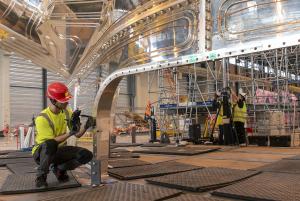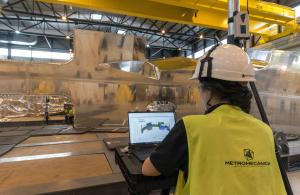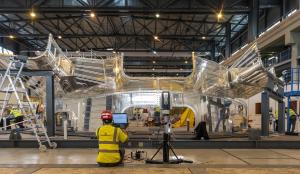Predicting deformation ahead of repair
Metrologists are required to assess the structural changes resulting from repairs—but in order to do so, they have to quantify several sources of variation.
In late 2022, the ITER metrology group was asked to support the thermal shield team by providing deformation data during specific repair steps such as clamping parts or removing, welding and buffing pipes. Because each of these tasks results in deformations of the highly flexible components, metrologists were called in to predict the nature and size of the deformations before each investigatory step and then measure the change after the work was done.
"We supported several test trials, including vacuum vessel thermal shield trials at both the segment and panel level, as well as testing on part of the cryostat thermal shield—namely the support thermal shield," says Lionel Poncet, assembly metrology engineer.
Thermal shield segments are made of assembled panels. At the segment level, tests included different sequences of pipe removal and buffing to assess deformation that would be induced by certain operations. Panel-level tests took place on the four to six panels that make up a segment, removing them from the segment to analyze separately.
Because the segments are so large, measuring around 15 metres by 10 metres in area, one of the challenges was that, due to obstructed lines of sight, not everything could be measured from the same instrument position, obliging the metrology team to take laser observations from multiple instrument locations. With the help of advanced metrology tools that use Monte Carlo equations to resolve measurement uncertainties, several observations were taken of each point in a network and then optimized.
Different sources of variation had to be quantified to determine the effects of repairs. One source is the pressure caused by supporting structures, which can change the shape of the relatively thin thermal shield panels. "Deformations can come either from the support or from the pipe removal," explains Poncet, "but what we really want to know is what comes from the pipe removal—so we need to separate the two. That's why the supporting conditions have to be monitored and controlled throughout the activity. We take reference measurements both with and without the support structures to evaluate the difference."
Variation also results when changes in temperature affect laser distance measurements. A subsystem in the laser instrument compensates for this effect with software that makes immediate adjustments based on live temperature readings together with pressure and humidity values.
Temperature fluctuations also affect the size of components—the warmer the ambient environment, the more the parts expand. Given the large size of the thermal shield components, even a small change in temperature can result in significant thermal distortion. That is why metrology was performed on the thermal shield segments and panels in a temperature-controlled building—the poloidal field coil facility on site.
"The ITER metrology team is accustomed to supporting the ITER units in all of their metrology needs," says Poncet. "So, when we received this request for the thermal shield in 2022, we geared up to do it by determining the as-built shape of the different components to be measured in order to set up references that could be monitored throughout the investigatory process. The trials performed through mid-2023 helped to contribute to the repair strategy that was defined that year, and which got underway after the selection of repair contractors."




